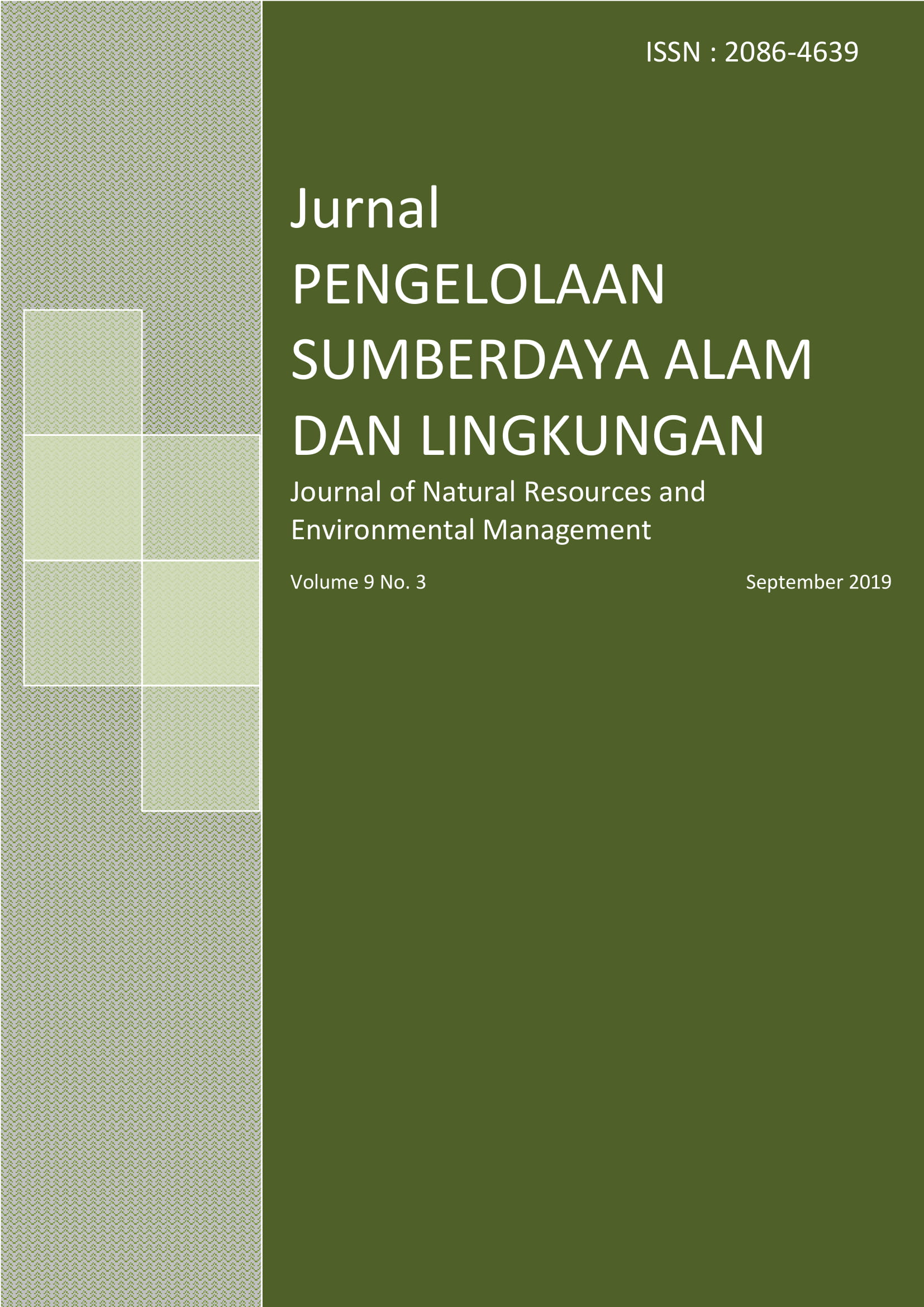Analisis Emisi GRK dan Konversi Energi pada Produksi Minyak Jarak (Ricinus communis L.) dengan Metode Life Cycle Assessment (LCA)
Abstract
References
[FAO] Food and Agricultural Organization. 2017. FAOSTAT [internet]. [diunduh pada 14 Agu 2017]. Tersedia pada: http://www.fao.org/faostat/en/#data/TP.
[ISO] International Standard Organization. 2006. ISO 14040 Enviromental Management – Life Cycle Asessment – Principles and Framework. Switzerland (CH): ISO.
[KLH] Kementerian Lingkungan Hidup. 2012. Pedoman Penyelenggaraan Inventarisasi Gas Rumah Kaca Nasional Buku II Volume 3 Metodologi Penghitungan Tingkat Emisi Dan Penyerapan Gas Rumah Kaca Pertanian, Kehutanan, Dan Penggunaan Lahan Lainnya. Jakarta: Kementrian Lingkungan Hidup.
Aldobouni IA, Fadhil AB, Saied IK. 2015. Conversion of de-oiled castor seed cake into bio-oil and carbon adsorbents. Energy Sources, Part A: Recovery, Utulization, and Environmental Effect. 37(24): 2617-2624.
Anam BK. 2015. Potensi Peningkatan Efisiensi Boiler dan Pengurangan Penggunaan Industrial Diesel Oil (IDO) pada Pabrik Gula [tesis]. Bogor: Institut Pertanian Bogor.
Bauddh K, Singh RP. 2012. Growth, tolerance efficiency and phytoremediation potential of Ricinus Communis (L.) and Brasica Juncea (L.) in salinity and drought affected cadmium contaminated soil. Ecotoxicology and Environmental Safety. 85: 13-22.
Canoira L, Galean JG, Aicantara R, Lapuerta M, Garcia-Contreras R. 2010. Fatty Acid Methyl Esters (FAMEs) from Castor Oil: production process assessment and synergetic effects in its properties. Renewable Energy. 35:208-217.
Cao L, Yuan X, Jiang L, Li C, Xiao Z, Hunag Z, Chen X, Zeng G, Li H. 2016. Thermogravimetric Characteristic and Kinetics Analysis of Oil Cake and Torrefied Biomass Blend. Fuel. 175;129-136.
Carlsson AS, Yilmaz JL, Green AG, Symne Sten, Hovfander P. 2011. Replacing fossil oil with fresh oil – with what and for what. European Journal of Lipid Science and Technology. 113:812-831.
Carrico CS, Fraga T, Carvalho VE, Pasa VMD. 2017. Polyurethane Foams for Thermal Insulation Uses Produced from Castor Oil and Crude Glycerol Biopolyols. Molecules. 22(7): 1091.
Chen GL, Chen GB, Li YH, Wu WT. 2014. A study of thermal pyrolysis for castor meal using taguchi method. Energy. 71; 62-70.
Elmunafi MHS, Yusof NM, Kurniawan D. 2015. Effect of cutting speed and feed in turning hardened stainless steel using coated carbide cutting tool under minimun quantity lubrication using castor oil. Advances in Mechanical Engineering. 7(8): 1-7.
Finkbeiner M, Inaba A, Tan RBH, Christiansen K, Kluppel HJ. 2006. The new international standards for life cycle assesment: ISO 14040 and ISO 14044. International Journal of LCA. 11(2):80-86.
Greco-Duarte J, Cavalcanti-Oliveira ED, Da Silva JAC, Fernandez-Lafuente R, Freire DMG. 2017. Two-step enzymatic production of environmentally friendly biolubricants using castor oil: enzyme selection and product characterization. Fuel. 202:196-205.
Harris, Anam S, Mahmudsyah S. 2013. Studi pemanfaatan limbah padat dari perkebunan kelapa sawit. Jurnal Teknik POMITS. 1(2).
Huang H, Yu N, Wang L, Gupta D.K, He Z, Wang K, Zhu Z, Yan X, Li T, Yang X. 2011. The phytoremediation potential of bioenergy crop ricinus communis for ddts and cadmium co-contaminated soil.
Bioresources Technology. 102:11034-11038.
Kiran dan Prasad. 2017. Ricinus communis L. (Castor bean), a potential multi-purpose environmental crop for improved and integrated phytoremediation. The Eurobiotech Journal. 1(2):1-16.
Klöpffer W, Grahl B. 2014. Life Cycle Assessment (LCA): A Guide to Best Practice. Weinhem (DE): Wiley-VCH Verlag GmbH
Lehman J, Gaunt J, Rondon M. 2006. Bio-charAH GAAH Sequestration in Terrestrial Ecosystems – A Review. Mitigation and Adaptaion Strategies for Global Change. 11: 403-427.
Mendes MG, Santos CDJr, Dias ACC, Bonetti AM. 2009. Castor Bean (Ricinus communis L.) as a Potential Environmental Bioindicator. Genetics and Molecular Research. 14(4): 12880-12887.
Olivares AR, Carrillo-Gonzales R, Gonzales-Chavez MDCA, Hernandez RMS. 2012. Potential of Castor Bean (Ricinus communis L.) for Phytoremrdiation of Mine Tailings and Oil Production. Journal of Environmental Management. 114: 316-323.
Parinduri L. 2016. Analisa Pemanfaatan Biomassa Pabrik Kelapa Sawit Untuk Sumber Pembangkit Listrik. Journal of Electrical Technology. 2(1): 37-40.
Authors
Authors who publish with this journal agree to the following terms:
- Authors retain copyright and grant the journal right of first publication with the work simultaneously licensed under a Creative Commons Attribution License that allows others to share the work with an acknowledgement of the work's authorship and initial publication in this journal.
- Authors are able to enter into separate, additional contractual arrangements for the non-exclusive distribution of the journal's published version of the work (e.g., post it to an institutional repository or publish it in a book), with an acknowledgement of its initial publication in this journal.
- Authors are permitted and encouraged to post their work online (e.g., in institutional repositories or on their website) prior to and during the submission process, as it can lead to productive exchanges, as well as earlier and greater citation of published work (See The Effect of Open Access).
Article Details
10.29244/jpsl.12.1.64-71
10.1016/j.biombioe.2025.107762






